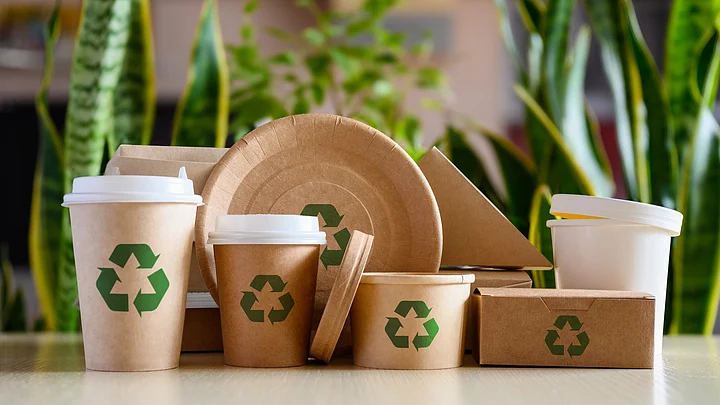In the relentless pursuit of a cleaner earth, businesses are turning to sustainable packaging alternatives to combat the looming plastic pollution crisis. Sustainable packaging is any type of eco-friendly material used to wrap, store, ship, or shelve products. As the urgency to find sustainable solutions intensifies, a collaboration between research teams exploring renewable bio-polymeric materials like bagasse, bamboo, areca palm, and more for fast-moving consumer goods (FMCG) applications have emerged as a transformative force.
This cross-business alliance unlocks a world of possibilities, allowing companies to study the bio-materials, structures, and applications for primary and secondary packaging to uncover the functionalization with diverse raw materials.
Through greater application-focused fundamental research and innovative explorations, this united front strives to promote the use of materials that are not only on par with plastic in functionality but also biodegradable or compostable, presenting a notable breakthrough for the industry.
Businesses Coming Together for a Cleaner Planet
Pioneering companies that view environmental responsibility as an integral part of their identity are at the forefront of this sustainable packaging revolution. Committed to creating a cleaner Earth, these companies invest in research and innovation to develop packaging materials that can be transformed into a circular loop and finally into nutrient-rich compost when disposed of properly. These visionary businesses recognise that the quest for sustainability goes hand in hand with pursuing excellence in material science, novel designs, and the creation of wealth out of waste.
Material Science Catalysing the Change
Material science, as a field of study, plays a pivotal role in redefining the very essence of packaging. With an ever-growing concern about plastic pollution and its detrimental effects on our ecosystems, researchers, scientists, and businesses are harnessing this discipline's power to seek both functional and eco-friendly alternatives. The scope of this exploration includes novel materials, formulations, processing, intermediates, applications, recycling, and finally compostability.
Compostable flexible packaging as an innovative solution
With its convenience and versatility, flexible packaging has changed the face of various industries, offering a lightweight and cost-effective solution for preserving and distributing goods. However, the proliferation of conventional plastic-based flexible packaging has led to a severe environmental crisis and poses a significant threat to our oceans, wildlife, and ecological balance. For example, India produces approximately 9.46 megatons of plastic waste each year. Unfortunately, 40% of this waste is not collected but burned, lost, or discarded in landfills or waterways.
Fuelled by the need for change, material scientists are exploring novel solutions to address this issue. The focus has shifted towards compostable flexible packaging, a promising avenue that holds the potential to mitigate the negative impact of plastic waste on the environment.
Compostable flexible packaging exemplifies responsible innovation, driven by a sense of responsibility to preserve our planet's delicate ecological balance. Companies are demonstrating their unwavering commitment to a cleaner and more sustainable future by explicitly stating their sustainability goals, driving research towards cost-effective recyclable and regenerative packaging, and encouraging the exploration of novel bio-materials like renewable cellulosic materials.
The potential of biomimicry
Using biomimicry can be an active way to solve the dilemma of setting up a sustainable ecosystem and establishing circular chain viability. In the packaging industry, especially for the lightweight structures catering to food products and F&Bs, discovering and innovating on new materials that come from the Earth and go back to their source will help establish a circular chain. However, due to the experimental nature of the research, pooling resources and efficiencies of different businesses grant the industry the economic advantage it needs. Further, shared findings create synergy for all players, from F&Bs to OEMs, to be on the same page. It streamlines the process of getting products out to market and improving accessibility instantaneously. A combination of such a lean system added to constant collaborative R&D can help the industry achieve the accelerated pace it requires to cut plastic pollution quickly.
Bottom Line
Overall, cross-business alliances require industry players to play to their strengths and function in tandem with one another on R&D focus, scale-up, and manufacturability. Further, research institutes catering to pilot and bulk-scale manufacturing will fast track the innovation on sustainable packaging. This is the way of nature as well, where different individual systems come together to create an ecosystem where co-dependencies help make the ecosystem viable.
Thus, collaborative research and action can help achieve faster progress. Companies need to make bold decisions to reduce the effects of plastic pollution. The onus of responsibility lies on the Government to encourage collaborative innovation-based sustainable business models and enact legislations to fast track market shift towards sustainable packaging, Industries to drive jointly and accelerate novel concepts towards commercialisation, and Innovators to join hands to bring forth the best solutions to drastically reduce plastics for a sustainable future.
(Dr Ramjee Subramanian is the Innovation Head at Pakka Limited - an Indian brand on a relentless mission of sustainability.)
(At The Quint, we question everything. Play an active role in shaping our journalism by becoming a member today.)
